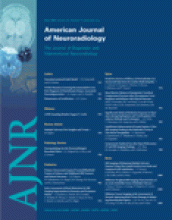Research ArticleFunctional
Positron-Emission Tomography of Brain Regions Activated by Recognition of Familiar Music
M. Satoh, K. Takeda, K. Nagata, E. Shimosegawa and S. Kuzuhara
American Journal of Neuroradiology May 2006, 27 (5) 1101-1106;
M. Satoh
K. Takeda
K. Nagata
E. Shimosegawa

References
- ↵Peretz I, Kolinsky R, Tramo M, et al. Functional dissociations following bilateral lesions of auditory cortex. Brain 1994;117:1283–301
- ↵Platel H, Price C, Baron JC, et al. The structural components of music perception. A functional anatomical study. Brain 1997;120:229–43
- ↵Loring D.W. INS Dictionary of Neuropsychology. New York: Oxford University Press;1999
- ↵Peretz I. Auditory agnosia: a functional analysis. In: McAdams S, Bigand E, eds. Thinking in sound. The cognitive psychology of human audition. New York: Oxford University Press;1993 :199–230
- ↵Zbikowski L.M. Cross-Domain Mapping. In: Zbikowski L.M. eds. Conceptualizing Music. New York: Oxford University Press;2002 :68–70
- ↵Satoh M, Takeda K, Murakami Y, et al. A case of amusia caused by the infarction of anterior portion of bilateral temporal lobes. Cortex 2005;41:77–83
- ↵Sergent J, Zuck E, Terriah S, et al. Distributed neural network underlying musical sight-reading and keyboard performance. Science 1992;257:106–09
- Zatorre RJ, Evans AC, Meyer E. Neural mechanisms underlying melodic perception and memory for pitch. J Neurosci 1994;14:1908–19
- ↵Halpern AR, Zatorre RJ. When that tune runs through your head: a PET investigation of auditory imagery for familiar melodies. Cereb Cortex 1999;9:697–704
- ↵Blood AJ, Zatorre RJ, Bermudez P, et al. Emotional responses to pleasant and unpleasant music correlate with activity in paralimbic brain. Nat Neurosci 1999;2:382–87
- ↵Benton AL. The amusias. In: Critchley M and Henson RA, eds. Music and the brain. London: William Heinemann Medical Books Limited;1977 :378–97
- ↵
- ↵Satoh M, Takeda K, Nagata K, et al. The anterior portion of the bilateral temporal lobes participates in music perception: a positron emission tomography study. AJNR Am J Neuroradiol 2003;24:1843–48
- ↵Kanno I, Iida H, Miura S, et al. A system for cerebral blood flow measurement using an H215O autoradiographic method and positron emission tomography. J Cereb Blood Flow Metab 1987;7:143–53
- ↵Minoshima S, Koeppe RA, Fessler JA, et al. Integrated and automated data analysis method for neuronal activation studies using [O-15] water PET. In: Uemura K, Lasen NA, Jones T, et al, eds. Quantification of brain function, tracer kinetics and image analysis in brain PET. Amsterdam: Excerpta Medica/Elsevier;1993 :409–17
- ↵Talairach J, Tournoux P. Co-planar stereotaxic atlas of the human brain. New York: Thieme;1988
- ↵Milner B. Laterality effects in audition. In: Mountcastle VB, eds. Interhemispheric Relations and Cerebral Dominance. Baltimore: Johns Hopkins University Press;1962 :177–95
- ↵Zatorre RJ. Discrimination and recognition of tonal melodies after unilateral cerebral excisions. Neuropsychologia 1985;23:31–41
- ↵Ayotte J, Peretz I, Rousseau I, et al. Patterns of music agnosia associated with middle cerebral artery infarcts. Brain 2000;123:1926–38
- ↵Nakamura K, Kawashima R, Sato N, et al. Functional delineation of the human occipitotemporal areas related to face and scene processing. A PET study. Brain 2000;123:1903–12
- ↵Nakamura K, Kawashima R, Sugiura M, et al. Neural substrates for recognition of familiar voices: a PET study. Neuropsychologia 2001;39:1047–54
- ↵Grabowski TJ, Damasio H, Tranel D, et al. A role for left temporal pole in the retrieval of words for unique entities. Hum Brain Mapping 2001;13:199–212
- ↵Yoo SS, Lee CU, Choi BG. Human brain mapping of auditory imagery: event-related functional MRI study. Neuroreport 2001;12:3045–49
- ↵Schurmann M, Raij T, Fujiki N, et al. Mind’s ear in a musician: where and when in the brain. Neuroimage 2002;16:434–40
- ↵Gainotti G. Neuropsychology of emotions. In: Denes G, Pizzamiglio L. eds. Handbook of clinical and experimental neuropsychology. East Sussex, UK: Psychology Press;1999 :613–33
- ↵Brown S, Martinez MJ, Parsons LM. Passive music listening spontaneously engages limbic and paralimbic system. Neuroreport 2004;15:2033–37
- ↵Fletcher PC, Frith CD, Baker SC, et al. The mind’s eye-Precuneus activation in memory-related imagery. Neuroimage 1995;2:195–200
- ↵McIntosh AR, Cabeza RE, Lobaugh NJ. Analysis of neural interactions explains the activation of occipital cortex by an auditory stimulus. J Neurophysiol 1998;80:2790–96
- ↵Zatorre RJ, Perry DW, Beckett CA, et al. Functional anatomy of musical processing in listeners with absolute pitch and relative pitch. Proc Natl Acad Sci U S A 1998;95:3172–77
In this issue
Advertisement
M. Satoh, K. Takeda, K. Nagata, E. Shimosegawa, S. Kuzuhara
Positron-Emission Tomography of Brain Regions Activated by Recognition of Familiar Music
American Journal of Neuroradiology May 2006, 27 (5) 1101-1106;
0 Responses
Jump to section
Related Articles
- No related articles found.
Cited By...
This article has not yet been cited by articles in journals that are participating in Crossref Cited-by Linking.
More in this TOC Section
Similar Articles
Advertisement











